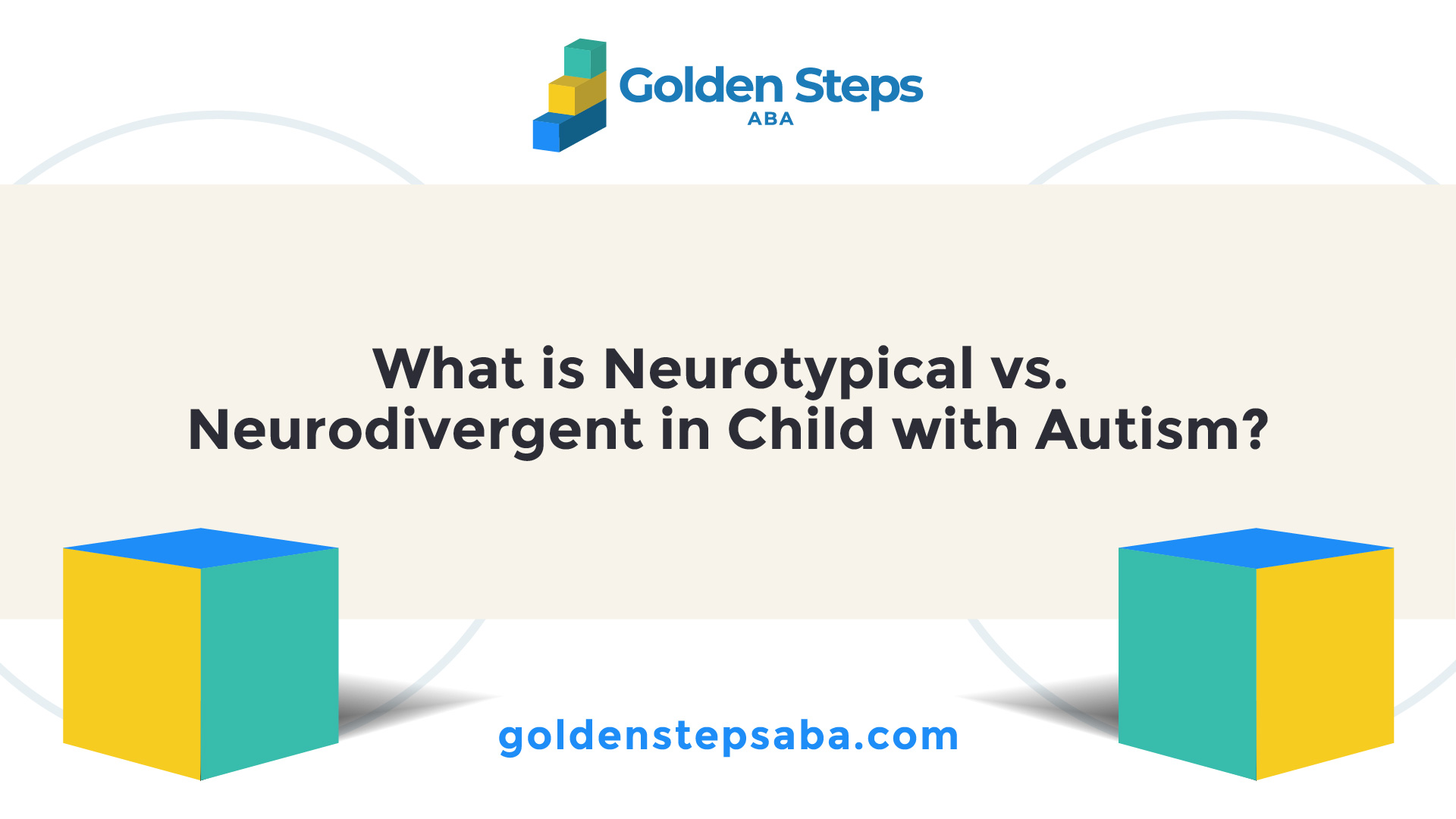Understanding Neurotypical and Neurodivergent
In understanding autism, it's crucial to comprehend the difference between neurotypical and neurodivergent individuals. This distinction helps to frame how people think, learn, and behave differently based on their neurological development.
Neurotypical vs. Neurodivergent Explained
Neurotypical refers to individuals who typically develop skills and behaviors according to a standard timeline and at a normal rate. This means their brains function in a way that is considered "typical" by societal norms. On the other hand, neurodivergent individuals behave, think, and learn differently. Their brains function differently from what is considered "typical". This includes individuals with conditions such as autism, ADHD, Tourette's, dyslexia, and other neurodiverse conditions. It's important to note that neurodivergence comes in many different forms and varying degrees. For example, some people with autism have higher support needs than others.
Neurodivergent children may exhibit signs such as difficulty in social situations, communication challenges, sensory sensitivities, and repetitive behaviors. You can learn more about the meaning of neurotypical in our article neurotypical meaning.

Embracing Neurodiversity
The term "neurodivergent" emerged from the concept of neurodiversity, which recognizes that everyone's brain develops uniquely, similar to fingerprints. There is no single definition of "normal" capabilities for the human brain, and neurodiversity acknowledges these differences. Embracing neurodiversity means acknowledging and valuing these individual differences rather than attempting to fit everyone into a narrow definition of "normal".
It's important to note that being neurodivergent is not a defect or a disorder, but a natural variation in human neurology. While neurodivergent individuals may face certain challenges due to their unique brain functions, they also bring different perspectives, skills, and talents to the table.
Creating a society that embraces neurodiversity is crucial to fostering acceptance and inclusion for all, regardless of whether one is neurotypical or neurodivergent. Understanding these terms is a crucial first step in supporting individuals on the autism spectrum and promoting a more inclusive society.
Characteristics of Neurotypical Individuals
When understanding the concept of "what is neurotypical vs neurodivergent?", it's important to delve into the characteristics that define each group. This section will explore the traits and developmental milestones of neurotypical individuals.
Traits of Neurotypical People
Neurotypical individuals, as the name suggests, have mental functions that align with what society deems "typical". They are those whose strengths and challenges are not affected by any differences that change how their brains work, in contrast to neurodivergent individuals.
These individuals think, perceive, and behave in ways that are considered the norm by the general population, with institutions typically designed to accommodate people who fit into these norms. For a more detailed explanation, you can read our article on the neurotypical meaning.
Developmental Milestones
In terms of development, neurotypical children typically develop skills and behaviors according to a typical timeline and at a typical rate. This means that they generally reach developmental milestones - such as walking, talking, and social interaction - within expected age ranges.
The term "neurotypical" refers to individuals with typical neurological development or functioning, not specific to any particular group, including autism spectrum disorder.
In contrast, neurodivergent children may exhibit signs such as difficulty in social situations, communication challenges, sensory sensitivities, and repetitive behaviors. These differences are not necessarily indicative of a problem, but rather a variance in human brain development and functioning.
To fully understand the difference in developmental milestones between neurotypical and neurodivergent children, you can refer to our article about the neurotypical child meaning.
By recognizing these characteristics and milestones, families can better understand the neurotypical development and how it may differ from neurodivergent development. This understanding is a key step towards creating a more inclusive and understanding society.
Traits of Neurodivergent Individuals
In the context of neurotypical vs neurodivergent discussions, it's essential to understand that neurodivergent individuals display unique traits and abilities that set them apart. These traits are characterized by diverse cognitive abilities and unique perspectives that can contribute positively to society.
Diverse Cognitive Abilities
Neurodivergent individuals, often diagnosed with conditions such as autism, ADHD, dyspraxia, dyslexia, Tourette’s syndrome, and OCD, possess mental functions that deviate from what society deems “typical”. These deviations, however, should not be seen as deficits. Instead, they often result in unique cognitive strengths and abilities.
For example, some neurodivergent individuals may possess enhanced memory skills, the ability to mentally picture 3D objects easily, or the ability to solve complex mathematical calculations in their head. However, these strengths can vary significantly from person to person based on their neurological differences.
It's critical to understand that these characteristics are neither inherently negative nor positive. They simply indicate differences in the way a neurodivergent person's brain works, compared to those who are neurotypical.
Unique Perspectives
The term neurodivergent is commonly used when a person's behavior, response, or thought process differs from societal or cultural expectations. However, these differences often result in unique perspectives that can bring about creativity, innovation, and problem-solving abilities.
Neurodivergent individuals often view the world in unique ways, leading to innovative solutions that might not be evident from a neurotypical perspective. Their unique thought processes can enhance the vibrancy of communities and workplaces, contributing to diversity and fostering collaboration.
By recognizing and embracing these unique perspectives, we can promote a culture of acceptance and inclusion, where neurodivergent individuals are valued for their contributions and supported in their endeavors. Understanding the traits of neurodivergent individuals is a step toward creating a more inclusive society where everyone's cognitive abilities are respected and valued.
Navigating Neurodiversity in Society
Understanding the concept of neurodiversity and the distinction between neurotypical and neurodivergent individuals is essential in creating an inclusive and accepting society. In this section, we will explore the challenges faced by neurodivergent individuals and discuss ways to promote inclusion and acceptance.
Challenges Faced by Neurodivergent Individuals
Neurodivergent individuals often face obstacles in societal structures designed primarily for neurotypical interactions. For example, typical classroom settings may pose challenges that lead to misunderstandings and negative labels like laziness or irresponsibility. These challenges can extend beyond the educational environment into various aspects of daily life, affecting their social interactions, career opportunities, and overall well-being.
Promoting Inclusion and Acceptance
Considering the unique challenges faced by neurodivergent individuals, it is crucial to promote inclusion and acceptance. Recognizing neurodiversity can be advantageous, especially in the workplace, where teams with neurodivergent professionals can be 30% more productive. They foster diversity of thought, innovation, and creativity, which can boost team morale and lead to different approaches to work [5].
Supporting neurodivergent employees aligns with ethical and legal obligations, promotes a fair and diverse workforce, and enhances social responsibility. Inclusive hiring practices that actively seek out neurodiverse talent can enrich society with unique skills and fresh perspectives [7].
Employers can support neurodivergent individuals by refraining from using sarcasm, euphemisms, or idioms in communication. Providing clear and concise instructions, offering guidance on workplace etiquette, establishing a consistent routine, and maintaining patience and kindness can create a supportive environment.
By tailoring processes to support neurodivergent employees, organizations demonstrate a commitment to diversity. This unlocks unique perspectives and talents, promotes innovation and collaboration, and enhances overall success and well-being.
In conclusion, understanding 'what is neurotypical vs neurodivergent?' is key in promoting an inclusive society. By recognizing and valuing neurodiversity, we can ensure that everyone, regardless of their neurological makeup, has the opportunity to thrive and contribute meaningfully to society.
Supporting Neurodivergent Individuals
To better understand the diverse cognitive and neurological differences that define neurodivergent individuals, it's important to explore the support and interventions available and how to create inclusive environments.
Tailored Support and Interventions
Neurodivergent individuals can access various resources and support to better understand their unique traits. One common approach includes taking neurodiversity quizzes, which can provide insights into their cognitive processing. However, these results should not be used as a formal diagnosis. Instead, they can be shared with a doctor to explain why they believe they may be neurodivergent, potentially leading to a referral to a specialist for a formal diagnosis.
Furthermore, employers can support neurodivergent individuals in the workplace by tailoring their communication and providing clear instructions. For instance, avoiding the use of sarcasm or idioms, offering concise instructions, and providing guidance on workplace etiquette can make a significant difference. Establishing a consistent routine and maintaining patience and kindness can also facilitate a supportive work environment [7].
Creating Inclusive Environments
Creating an inclusive environment for neurodivergent individuals goes beyond providing support—it's about recognizing and embracing their unique perspectives, talents, and creativity. By doing so, communities and workplaces can benefit from innovative problem-solving and collaboration, enriching overall vibrancy.
Inclusion also extends to hiring practices that actively seek out neurodiverse talent, enriching the workforce with unique skills and fresh perspectives. Employers who support neurodivergent employees demonstrate a commitment to diversity and social responsibility, aligning with ethical and legal obligations [7].
By tailoring processes to support neurodivergent employees, organizations can unlock unique perspectives and talents, promote innovation and collaboration, and enhance overall success and well-being.
In the quest to demystify 'what is neurotypical vs neurodivergent?' it is essential to focus not only on understanding the traits of neurotypical and neurodivergent individuals, but also on creating supportive, inclusive environments that recognize and celebrate neurodiversity. For more insights on the meaning of neurotypical, you can visit neurotypical meaning and for a child-specific perspective, neurotypical child meaning.
Benefits of Embracing Neurodiversity
Understanding the concept of neurodiversity and its implications can provide numerous benefits, particularly in contexts that value diversity of thought and creativity. Recognizing the unique strengths and abilities of neurodivergent individuals can foster innovation, collaboration, and success in various settings.
Diversity in Thought and Innovation
Embracing neurodiversity can be advantageous, especially in the workplace. Teams with neurodivergent professionals can be 30% more productive, fostering diversity of thought, innovation, and creativity. This increased productivity is attributed to the unique perspectives and approaches that neurodivergent individuals bring to their work.
Inclusive hiring practices that actively seek out neurodiverse talent not only align with ethical and legal obligations but also promote a fair and diverse workforce, and enhance social responsibility. Such practices enrich society with unique skills and fresh perspectives that align with the true meaning of neurotypical vs neurodivergent.
Fostering Collaboration and Creativity
In addition to promoting diversity and innovation, embracing neurodiversity also fosters collaboration and creativity. A strength-based relationship with neurodiverse individuals allows organizations to tap into diverse skills, enhance creativity and problem-solving, and foster a culture that values unique contributions.
Providing necessary accommodations for success in both educational and professional contexts is essential. Employers can support neurodivergent individuals by offering clear and concise instructions, providing guidance on workplace etiquette, establishing a consistent routine, and maintaining patience and kindness.
Tailoring processes to support neurodivergent employees demonstrates a commitment to diversity, unlocks unique perspectives and talents, promotes innovation and collaboration, and enhances overall success and well-being in organizations [7].
In conclusion, understanding 'what is neurotypical vs neurodivergent?' and embracing neurodiversity offers numerous benefits. It not only creates a conducive environment for neurodivergent individuals but also enriches society with diverse perspectives and unique talents.

